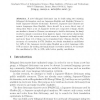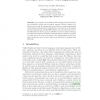124 search results - page 4 / 25 » The Use of SVM for Chinese New Word Identification |
PR
2000
13 years 5 months ago
2000
In this paper, a novel algorithm is presented for writer identification from handwritings. Principal Component Analysis is applied to the gray-scale handwriting images to find a s...
IJCNLP
2005
Springer
13 years 11 months ago
2005
Springer
A new bilingual dictionary can be built using two existing bilingual dictionaries, such as Japanese-English and English-Chinese to build Japanese-Chinese dictionary. However, Japan...
ACL
2006
13 years 7 months ago
2006
This paper presents a new approach based on Equivalent Pseudowords (EPs) to tackle Word Sense Disambiguation (WSD) in Chinese language. EPs are particular artificial ambiguous wor...
MVA
1990
13 years 7 months ago
1990
A new high speed word matching algorithm for handwritten Chinese character recomition is presented. Acontinuous string without delimiting space is recognized in real time by using...
IDA
2001
Springer
13 years 10 months ago
2001
Springer
Abstract. We propose a new unsupervised training method for acquiring probability models that accurately segment Chinese character sequences into words. By constructing a core lexi...



